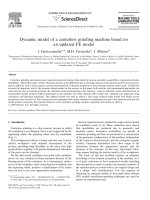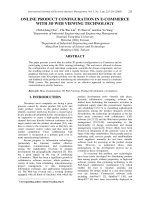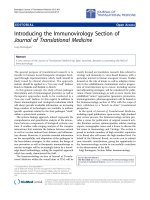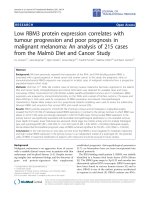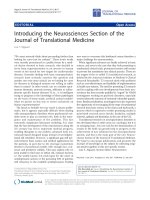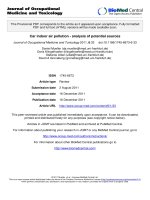Cooney and Cooney International Journal of Emergency Medicine 2011, 4:14 potx
Bạn đang xem bản rút gọn của tài liệu. Xem và tải ngay bản đầy đủ của tài liệu tại đây (793.11 KB, 4 trang )
CAS E REP O R T Open Access
Gas gangrene and osteomyelitis of the foot in a
diabetic patient treated with tea tree oil
Derek R Cooney
*
and Norma L Cooney
Abstract
Diabetic foot wounds represent a class of chronic non-healing wounds that can lead to the development of soft
tissue infections and osteomyelitis. We reviewed the case of a 44-year-old female with a diabetic foot wound who
developed gas gangrene while treating her wound with tea tree oil, a naturally derived antibiotic agent. This case
report includes images that represent clinical examination and x-ray findings of a patient who required broad-
spectrum antibiotics and emergent surgical consultation. Emergency Department (ED) detection of these
complications may prevent loss of life or limb in these patients.
Background
The lifetime incidence of diabetic foot ulcers may be as
high as 25% [1]; however, ga s gangrene is not common
in these patients. The most common causative organism
in gas gangrene is Clostridium perfringens [2]. It is also
important to rule out underlying osteomyelitis. In
patients with diabetic foot ulcers, Streptococcus group A,
Stap hlococcus aureus and Pseudo monas may be present.
If surgical debridement and antibiotics are not effecti ve,
amputation may be required.
Tea tree o il, the essential oil of Melaleuca alternifolia,
is a commonly available, naturally derived, topical anti-
septic. Tea tree oil is known to possess antibiotic activ-
ity toward a broad spectrum of pathogens, including
methicillin-resistant Staphylococcus aureus (MRSA) and
Candida albicans [3].
Case Presentation
A 44-year-old female with a history of diabetes pre-
sented to the Emergency Department complaining of
increased right foot pain for 3-4 days with redness and
swelling. She had been applying tea tree oil to the
wound. Her vital signs were blood pressure: 91/50, heart
rate: 111, respiratory rate: 20, temperature: 36.4°C and
oxygen saturation: 100% on room air. There were swel-
ling and inflammation to the right foot and a foul-smel-
ling odor. Dark blisters were noted with erythema
tracking up the lateral aspect of the leg. There was a 4
× 3 × 2.5 cm ulcer plantar surface of the foot with
maceration of the pe riwound skin and a serosanguinous
drainage that had a mild odor. She was able to plantar
anddorsiflex,andhaddiminishedfinesensation.The
patient had 1+ dorsalis pedis pulses and normal capillary
refill. Laboratory studies showed a WBC of 14.7, neutro-
phils 74% with 17% bands. Radiographs of the right foot
showed subcutaneous and deep fascial emphysema of
the foot with extension along the plantar surface. Irregu-
larities consistent with osteomyelitis of the distal first
metatarsal and distal secon d proximal phalanx were
noted.
After admission, the patient was treated with clinda-
mycin and underwent a transmetatarsal amputation.
Blood cultures were negative, and wound cultures were
deemed inconclusive. Wound infection d eveloped, and
the patient was treated with vancomyci n and moxifloxa-
cin. An ankle disarticulation was performed. The wound
did well at that point and the rest of the hospital course,
and outpatient management was unremarkable.
Discussion
Diabetic foot ulcers are a significant complication and are
credited with causing 85% of limb amputations among
diabetics. In a review by Sing et al., limb amputation was
associated with 39-80% 5-year mortality [1]. Diabetic foot
ulcers are usually the result of some minor trauma that
may be secondary to the patient’ s decreased sensation.
Ulceration in areas of increased pressure is also common.
Usually offloading, debridement, advanced wound care
* Correspondence:
Department of Emergency Medicine, Division of Hyperbaric Medicine, SUNY
Upstate Medical University, EMSTAT Center/550 East Genesee, Syracuse, New
York 13202, USA
Cooney and Cooney International Journal of Emergency Medicine 2011, 4:14
/>© 2011 Cooney and Cooney; licensee Springer. This is an Open Access article distributed under the terms of the Creative Commons
Attribution License ( which permits unrestricte d use, distribution, and reproduction in
any medium , provided the original work i s properly cited.
dressings and close follow-up result in improvement of
these wounds. Hyperbaric oxygen therapy is also com-
monly used as an adjunct in the care of these wounds.
These are chronic wounds and require weeks of therapy
and numerous clinic visits. When care is not taken to
prevent infection, the wounds ca n become deep, and
osteomyelitis and serious soft tissue infection may occur.
Tea Tree Oil
A particularly interesting element of this case is the
patient’ s use of the home remedy, tea tree oil. This
essential oil is bactericidal and known to have some
broad-spectrum antibiotic affects [3-8]. Tea tree oil is
one of a number of essential oils that possesses an active
monoterpeneconstituent.InastudybyCoxetal.,the
monoterpene in tea tree oil was shown to damage cell
membranes and inhibit cellular respiration in Escher ia
coli, Staphylococcus aureus and Candida albicans [4]. It
has also been shown to have activity against Pseudomo -
nas species [6]. Tea tree oil has been demonstrated to
have antibiotic effects on a number of bacteria, includ-
ing important skin flora like methicillin-resistant Staphy-
lococcus aureus [3]. In addition to its antiseptic,
antibiotic and antifungal activity, tea tree oil also has
some anti-inflammatory effects [7]. The antiseptic prop-
erty of tea tree oil likely explains the lack of useful
wound culture results in this case.
Assessement
Pain is a common presenting complaint and may be the
first sign in patients with gas gangrene. Bullae and the
bluish skin discoloration are classic findings of gas gang-
rene and were noted have begun to show at the time of
presentation of this case (Figures 1 and 2). Edema and
crepitus are usually present at the time of diagnosis;
however, some references state that as many as 50% of
cases may not have discernable crepitus or gas on radio-
graphs on initial presentation [9]. The patient’speri-
wound areas were also quite macerated. This was due to
the moderate amount of serosanguinous drainage the
patient was having, which is also common with gas
gangrene. This drainage is often described as having a
“sickly sweet” odor.
X-ray images should be obtai ned in patients wit h dia-
betic foot ulcers to evaluate for the presence of osteo-
myelitis and gas in the soft tissues. Osteomyelitis was
noted in this case; however, the soft tissue gas is much
more prominent (Figure 3). The presence of gas on x-
ray of the affected area should prompt the clinician to
obtain images up t o the next proximal joint in order to
ascertain the extent of the infection [10]. In cases where
gas is not seen, but deep space soft tissue infection is
suspected, computed tomography (CT) or magnetic
resonance imaging (MRI) may be appropriate.
Management
Emergency department treatment for patients w ith
signs of cellulitis with or without crepitus includes
intravenous (IV) antibiotics. Antibiotic choice is var-
ied and may be institutionally dependent. Broad-spec-
trum penicillins, such as Piperacillin-tazobactam,are
most commonly employed [11]. Superficial wounds
can be debrided, and eschers and fibrous caps
removed, if the ED practitioner is skilled in these pro-
cedures. Drainage and debrided material should be
cultured. Clinical response to therapy and culture
results are usually used to direct changes in antibiotic
therapy during the inpatient phase of management. It
is important to remember that (IV) and oral antibio-
tics do not penetrate devascularized tissues. Gangrene
and deep space infections require surgical debride-
ment in the operating room. Some patient presenta-
tions may be complicated by sepsis or shock, and IV
fluid therapy is indicated along with other supportive
measures.
Aggr essive debridement may be necessary for wounds
associated with crepitus. Surgical exploration may help
determine whether the condition is crepitant cellulitis
Figure 1 Dorsal aspect reveals ulceration of secong digit,
blisters and discoloration.
Cooney and Cooney International Journal of Emergency Medicine 2011, 4:14
/>Page 2 of 4
verses gas gangrene. Necrotic and infected tissues,
including muscle and fascia, should be removed, and
healthy tissues should be preserved if possible. During
surgical exploration, it may become apparent that ampu-
tation is n ecessary, which is the case in 25% of severe
diabetic foot infections [10].
In addition to its role in chronic management of dia-
betic foot ulcers, hyperbaric oxygen therapy (HBOT)
may have a role in the acute management of patients
that develop infectious complications of their wound(s).
A review by Kaide et al. states that HBOT has been
shown to suppress alpha toxin of Clostridium, enhance
leukocyte-killing activity, enhance destruction of anaero-
bic bacteria, suppres s bacterial growth, enhance antibio-
tic effects, and improve tissue repair in poorly
vascularized tissues [9]. The review also states that
HBOT, when added to antibiotics and surgery, has also
been found to reduce the rate of mortality and morbid-
ity (including amputation). D uring surgery, patients
undergoing HBOT were found to have clearer demarca-
tion between viable and necrotic tissues, allowing for
improved surgical debridement.
Conclusion
Although an uncommon com plication of diabetic foot
ulcer, gas gangrene may develop in patients with these
chronic non-healing wounds. Special care must be taken
in the ED evaluation of these wounds to rule out the
diagnosis of soft tissue infections , as well as osteomyeli-
tis. The management of gas gangrene requires rapid
recognition and immediate therapy. In addition to broad
spectrum antibiotics and surgical consultation, the ED
physician may also consider consulting f or HBOT and
ICU evaluations if appropriate.
Consent
Written informed consent was obtained from the patient
for publication of this case report and accompanying
images. A copy of the written consent is available for
review by the Editor-in-Chief of this journal.
Authors’ contributions
NC participated in the care of the patient and provided case details. DC
obtained consent, obtained photographs, prepared images, reviewed reports
and performed literature searches. Both DC and NC reviewed the literature
and provided authorship of the text of this manuscript.
Figure 2 Plantar aspect reveals diabetic foot ulcer.
Figure 3 X-ray reveals soft-tissue gas consistent with gangrene.
Cooney and Cooney International Journal of Emergency Medicine 2011, 4:14
/>Page 3 of 4
Competing interests
The authors declare that they have no competing interests.
Received: 13 March 2011 Accepted: 14 April 2011
Published: 14 April 2011
References
1. Singh N, Armstrong DG, Lipsky BA: Preventing foot ulcers in patients with
diabetes. JAMA 2005, 293(2):217-28.
2. Brook I: Microbiology and management of soft tissue and muscle
infections. Int J Surg 2008, 6(4):328-38.
3. Woollard AC, Tatham KC, Barker S: The influence of essential oils on the
process of wound healing: a review of the current evidence. J Wound
Care 2007, 16(6):255-7.
4. Cox SD, Mann CM, Markham JL, Bell HC, Gustafson JE, Warmington JR,
Wyllie SG: The mode of antimicrobial action of the essential oil of
Melaleuca alternifolia (tea tree oil). J Appl Microbiol 2000, 88(1):170-5.
5. Carson CF, Riley TV: Antimicrobial activity of the major components of
the essential oil of Melaleuca alternifolia. J Appl Bacteriol 1995,
78(3):264-9.
6. Papadopoulos CJ, Carson CF, Hammer KA, Riley TV: Susceptibility of
pseudomonads to Melaleuca alternifolia (tea tree) oil and components. J
Antimicrob Chemother 2006, 58(2):449-51.
7. Hammer KA, Dry L, Johnson M, Michalak EM, Carson CF, Riley TV:
Susceptibility of oral bacteria to Melaleuca alternifolia (tea tree) oil in
vitro. Oral Microbiol Immunol 2003, 18(6):389-92.
8. Halcón L, Milkus K: Staphylococcus aureus and wounds: a review of tea
tree oil as a promising antimicrobial. Am J Infect Control 2004, 32(7):402-8.
9. Kaide CG, Khandelwal S: Hyperbaric oxygen: applications in infectious
disease. Emerg Med Clin North Am 2008, 26(2):571-95.
10. Zgonis T, Stapleton JJ, Girard-Powell VA, Hagino RT: Surgical management
of diabetic foot infections and amputations. AORN J 2008, 87(5):935-46.
11. Fincke BG, Miller DR, Christiansen CL, Turpin RS: Variation in antibiotic
treatment for diabetic patients with serious foot infections: a
retrospective observational study. BMC Health Serv Res 2010, 10:193.
doi:10.1186/1865-1380-4-14
Cite this article as: Cooney and Cooney: Gas gangrene and
osteomyelitis of the foot in a diabetic patient treated with tea tree oil.
International Journal of Emergency Medicine 2011 4 :14.
Submit your manuscript to a
journal and benefi t from:
7 Convenient online submission
7 Rigorous peer review
7 Immediate publication on acceptance
7 Open access: articles freely available online
7 High visibility within the fi eld
7 Retaining the copyright to your article
Submit your next manuscript at 7 springeropen.com
Cooney and Cooney International Journal of Emergency Medicine 2011, 4:14
/>Page 4 of 4
